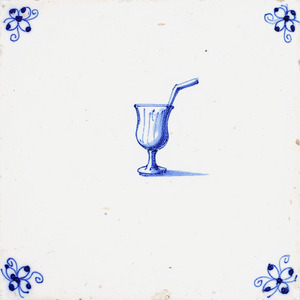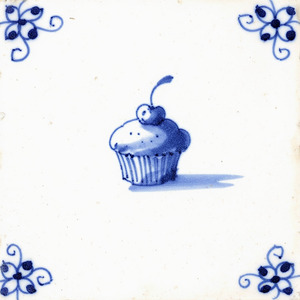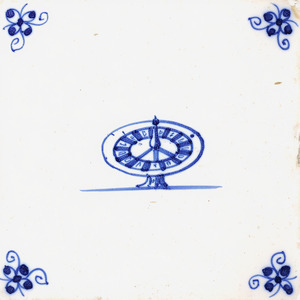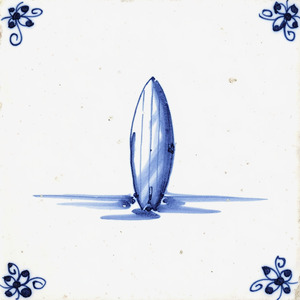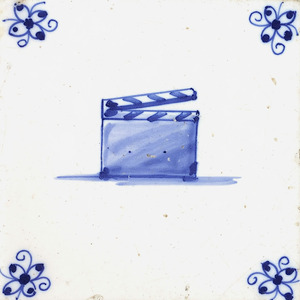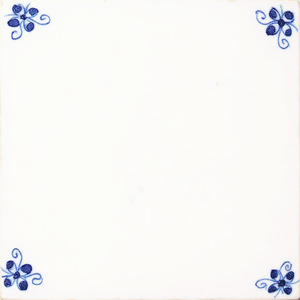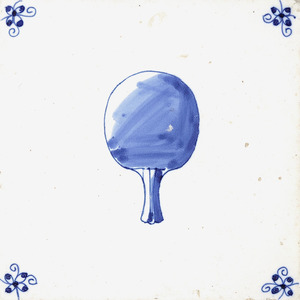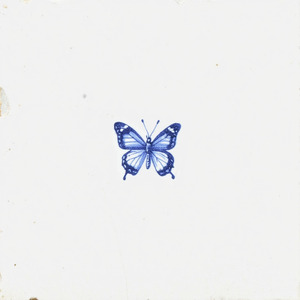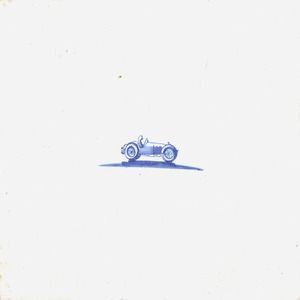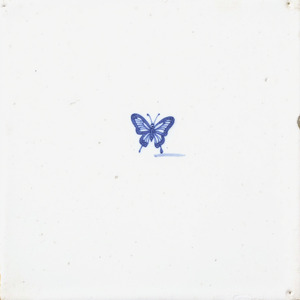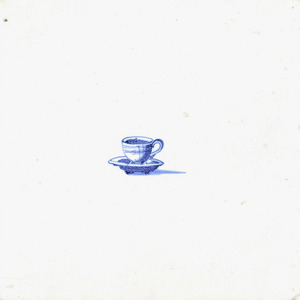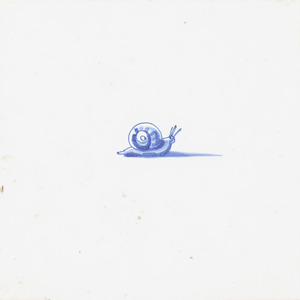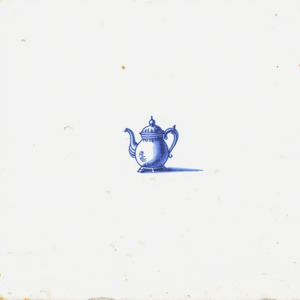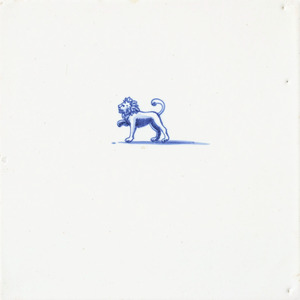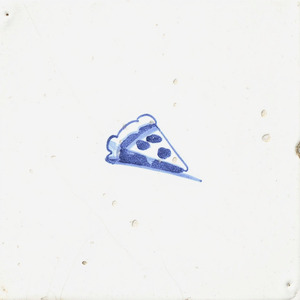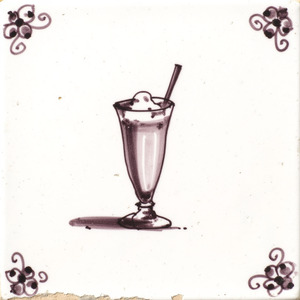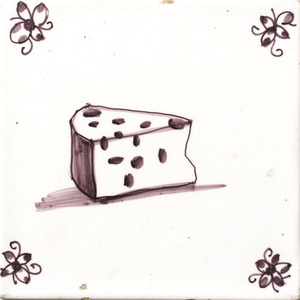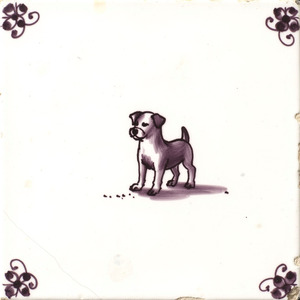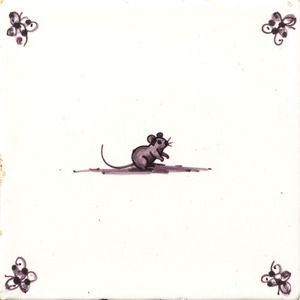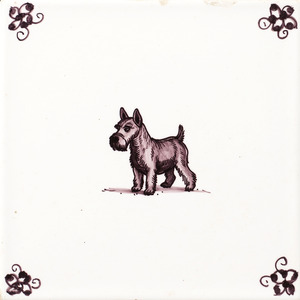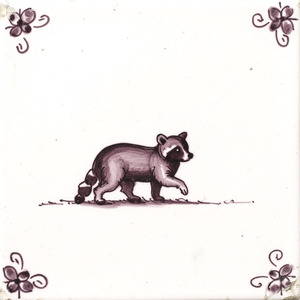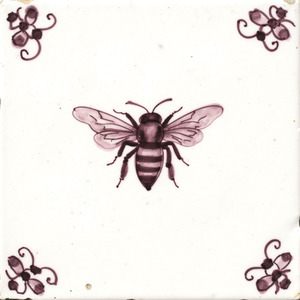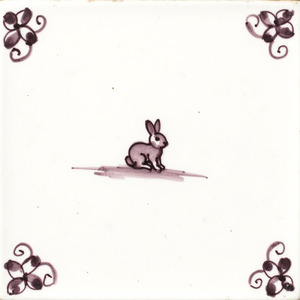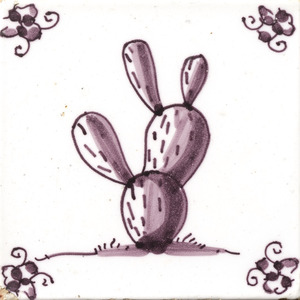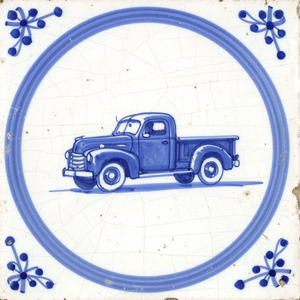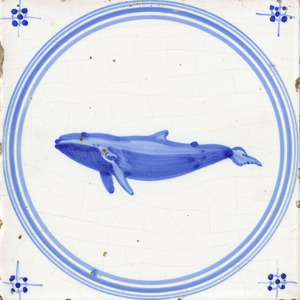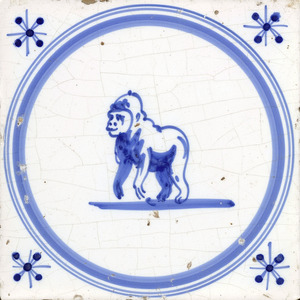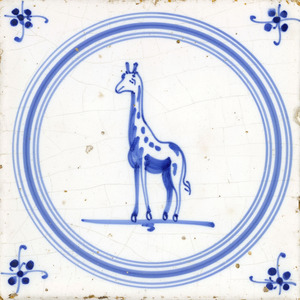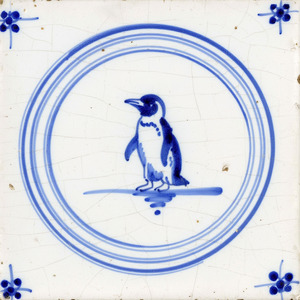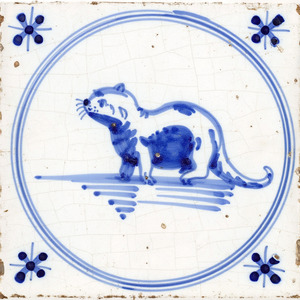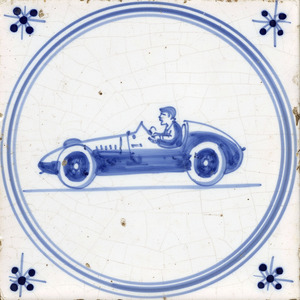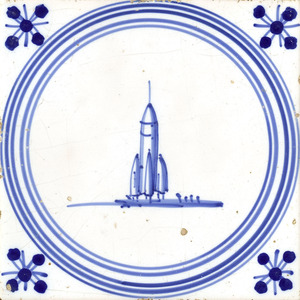For each historic style, offer a range of different models, each based on a set of specific historic examples. A “model” just means a way of interpreting the same prompt.
By the 1640s Dutch tile-painters began slimming down their borders to a single, quick flourish in each corner: a few mirrored curls and a dot that together resemble a tiny spider's web, hence the name spin ('web' or 'spider' motif). The motif leaves the field relatively blank, giving each tile a crisp, minimalist look while allowing adjoining pieces to line up in perfectly balanced grids. It was among the most common corner motifs in Delftware historically, and it is very much our flagship style. Our AI model captures that crisp minimalism, including tiny chips, a nod to the well-loved originals it was trained on.
Make your own!

By the 1660s a new Delft look appeared: tiles with no corner motifs at all, just a lone emblem floating on a wide field of milky tin-glaze. Dropping the fleur-de-lys, ox-head and web corners reduced both pigment costs and painting time, the culmination of a decades-long shift from busy, polychrome maiolica to the spare blue-and-white of the Dutch Golden Age. The result is gorgeously minimalist and perfectly at home in modern interiors. This AI model leans into that minimalism, generating tiles with ultra-small emblems that give maximum breathing room to whitespace.
Make your own!

Imported Ming 'kraak' porcelain set off a craze for the Chinese-meander border in Dutch tiles from the early seventeenth: a continuous key-fret ribbon on all four sides of the tile. Almost always painted in deep cobalt, the meander frames a neat round medallion so the centre scene pops against the busy border. The pattern's rhythmic snap still feels striking today. Our AI model echoes that tight geometry, deep blue, and complex shapes.
Make your own!

Alongside the classic blue and white, the Dutch also used manganese to create richly purple tiles, emerging in the late 17th century and that represent a distinctive phase in Delftware production. These tiles, characterized by their rich, deep purple hues derived from manganese oxide, showcase intricate designs that blend Dutch artistic traditions with diverse foreign influences.
Make your own!

Similar stylistically to our fleur-de-lys style, this is a minimal and traditional style, with a vine leaf (called wingerdblad in Dutch) in each corner.
Make your own!

This model, based on the style known in Dutch as the 'balustertegel' was fashionable from 1620 to 1640. Each tile is framed by two elegantly curved, Mannerist balusters (or half candlesticks, giving this style is alternative name of kandelabertegel) and anchored by four fleur-de-lys in the corners. It was particularly popular in Rotterdam, but was also produced in other Dutch cities. This model is quite promptable and has a heavy, dark blue look.
Make your own!

Willem Jansz Verstraeten made his Haarlem workshop famous with his signature aigrette motif: a garland of paired, feather-like strokes named after the heron plumes especially popular in seventeenth-century hats. Painted in cobalt and often enhanced with golden pigment, as we do here, the light style lets adjoining tiles lock into one continuous field.
Make your own!

Delft tiles did not exist in separation from the cultural and artistic context of their times. Styles — including the Baroque that gripped Europe in the seventeenth and eighteenth centuries — profoundly impacted its progress. This style, like our Greek A style, was particularly inspired by the contemporary engravings of Daniel Marot. Each scene is framed neatly in an oval cartouche, and the overall style is playful and classical, while still retaining the classic Delft blue and white.
Make your own!

Early Delftware, prevalent in the late 1500s to early 1600s, emerged as a transitional style between Italian-Spanish Majolica and the classic blue-and-white Delftware. Characterized by bright colors, ornate patterns, and restricted imagery, it originated when Italian potter Guido da Savino established the first majolica workshop in Antwerp around 1500. This style featured a diverse color palette, elaborate ornamentation, and central emblems often enclosed in thick painted frames. Large corner motifs created a strong carpet effect when tiles were arranged together. While rooted in Majolica traditions, Early Delftware gradually developed its own distinctive look, incorporating more everyday subjects and loosening frame designs. This style offers rich historical context and visually striking elements.
Make your own!

This stylized depiction of a lily flower is, of course, most associated with the French kings and the French ancien regime more broadly. However, it was a very popular corner motif on Delftware tiles throughout the period of its flourishing, even as geopolitical confrontations between France and the Low Countries raged.
Make your own!

The Greek A (De Grieksche A) factory — so named for the distinctive mark on its pottery — operated in Delft from 1658 to 1811. This style is an ode to their busy, classicising style of the turn of the eighteenth century under the ownership of Adrianus Kocx. The influence of French Huguenot emigré and engraver Daniel Marot lends a specific Baroque touch to many of their designs. They were collected abroad, including at Hampton Court in England under the reign of William and Mary.
Make your own!
Adopted from the 1620s, the ox-head (ossenkop) corner quickly became Delftware's all-purpose frame. Painted mostly in cobalt blue, the motif freed painters to focus on lively centres (soldiers, ships, mythic beasts or whatever else came to their mind) while giving whole walls a neat visual grid. Our AI model captures that brisk, working-kiln look with quite a loose, rough style.
Make your own!
Delftware tiles were not always blue and white. In the 18th century, polychrome tiles were also popular, with a variety of colors and designs. This style is inspired by the polychrome tiles of the period, with a rainbow of ornamental borders with an octagonal frame.
Make your own!Similar to our other two roundel styles, this style features ox-head (ossenkop) corner motifs.
Make your own!

The classic roundel framing, combined with delicate web corner motifs, was a signature style of Dutch Delftware that balanced structure with movement. The circular frame creates a porthole-like window into the scene, while the almost floral corners (which are in fact, inspired by spiders webs!) add a sense of energy and decoration to the otherwise empty spaces. This pairing was particularly popular for landscape scenes and architectural studies, as the roundel naturally draws focus to the central composition.
Make your own!

This style is similar to our flagship web style, but with a much looser look. This was the first model we released, and it remains popular with some customers, though it can often have a more digital look.
Make your own!

When Delft tiles weren't just one or two colours, they could really stand out! This pattern is an allusion to so-called nail tiles which showed tropical birds in full colour, perched on a nail. These tiles were particularly popular in the 18th century.
Make your own!

